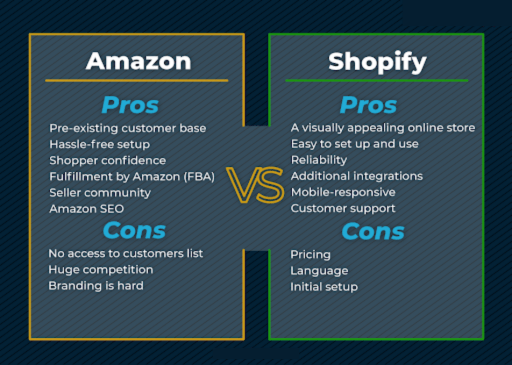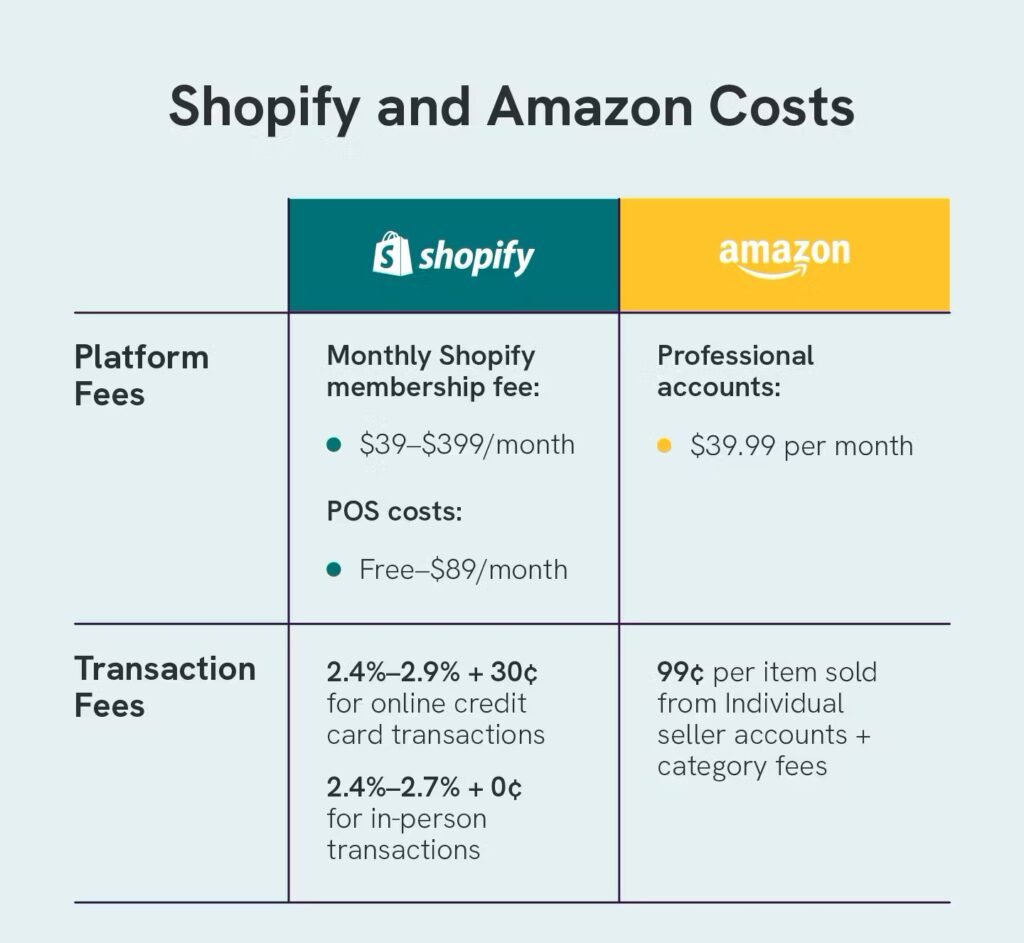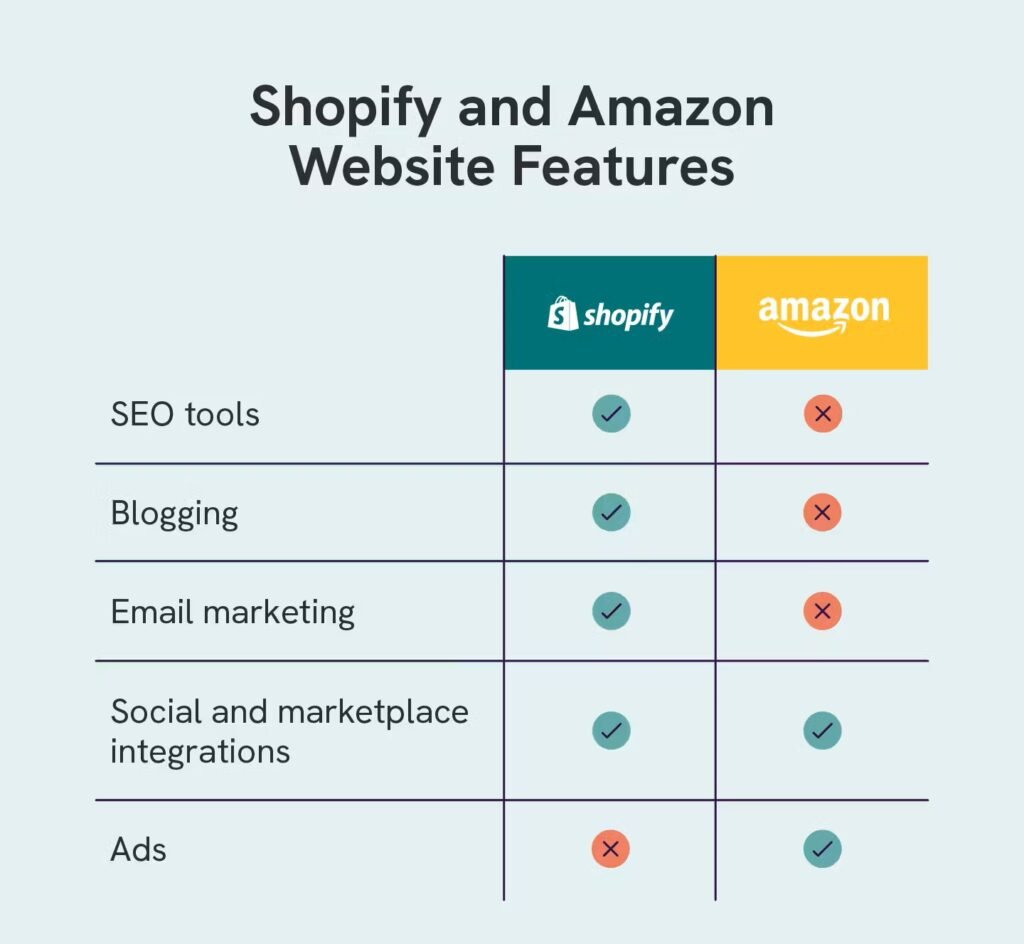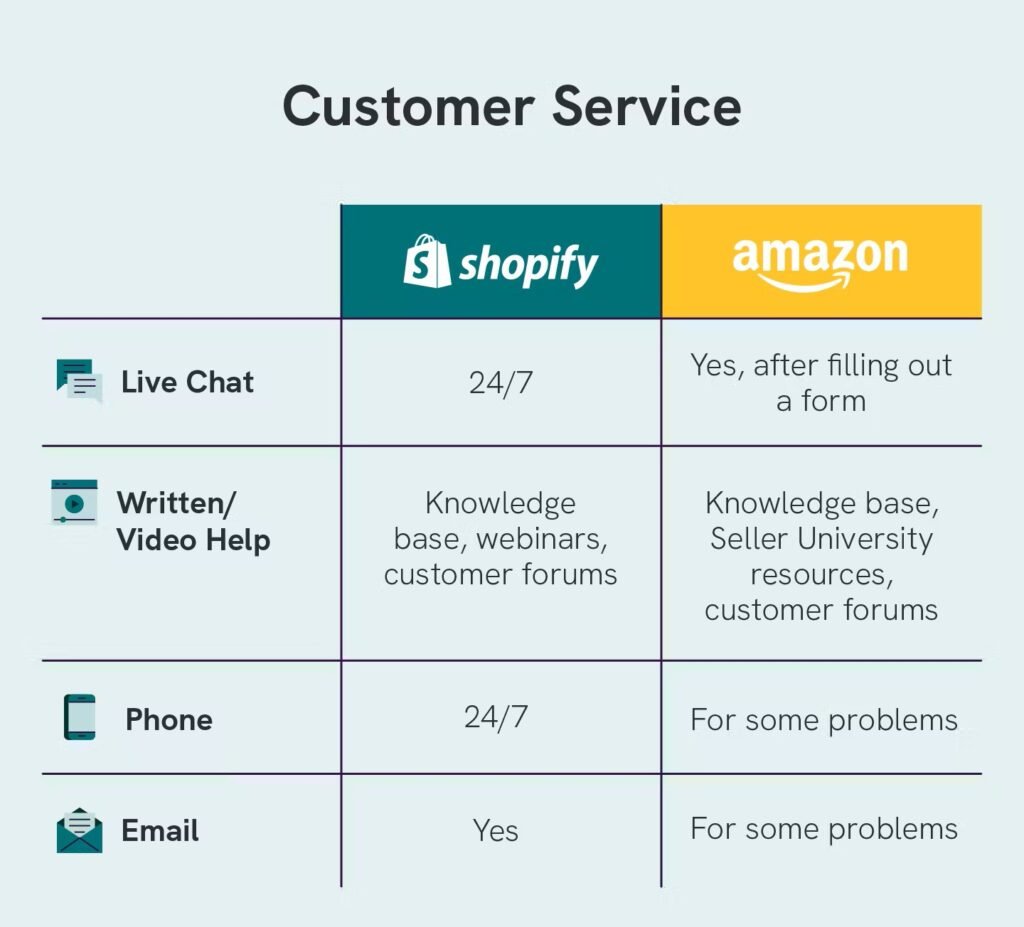The world of eCommerce offers two giant e-commerce platforms that dominate the space: Shopify and Amazon. Both platforms have empowered millions of entrepreneurs to start and scale their businesses. However, selecting the right platform for your online store depends on your business goals, products, and growth strategy.
Here, we’ll break down the 9 key factors to help you decide between the both, ensuring you choose the best eCommerce platform for your unique needs.
What Makes Shopify and Amazon Unique?
Both Shopify and Amazon are major players in eCommerce space, but they cater to different needs and offer distinct advantages. Here’s a deeper look at what makes each platform unique:
Shopify
It is a standalone platform that allows you to build, design, and manage your online store from scratch. You have full control over your store’s branding, user experience, and customer data. This makes it an excellent choice for businesses aiming to create a personalized shopping environment tailored to their target audience.
Amazon
It operates as a centralized marketplace where sellers list their products alongside millions of others. The platform provides instant access to a vast audience, but it comes at the cost of limited branding opportunities. It prioritizes a uniform shopping experience, meaning your ability to differentiate your store is minimal. However, the exposure to millions of customers is unmatched, making it a solid choice for sellers seeking quick sales without heavy marketing efforts.

1. Ownership and Branding
Shopify
One of its strongest advantages is the complete ownership it provides. As an owner of its store, you control your website domain, customer data, and the overall customer experience. This control allows businesses to build a strong, recognizable brand without interference from external platforms. You can customize every aspect of your store, from design and layout to marketing strategies, enabling you to create a distinct identity that resonates with your audience and making greater revenue.
Amazon
In contrast, it retains control over much of the branding and customer interaction. Sellers on this site operate within its ecosystem, where products are listed under its branding. This means customers often associate the purchase with it rather than the individual seller. Additionally, it limits access to customer data, making it challenging to build direct relationships or personalize marketing efforts. For sellers who prioritize branding and customer loyalty, this can be a significant drawback.
2. Cost and Fees
Their cost and fee structure is slightly different and it is described below:
Shopify
Shopify operates on a subscription-based model, offering pricing plans starting at $29 per month. Depending on the features you need, higher-tier plans are available, which can increase monthly costs. Transaction fees are also applied unless you use Shopify Payments, the platform’s built-in payment processor. While these costs can add up, they come with significant flexibility, allowing you to control your profit margins more effectively.
Amazon
Its cost structure is largely based on sales. For professional sellers, a monthly fee of $39.99 applies, along with referral fees that range from 6% to 45% depending on the product category. These referral fees can significantly cut into your profits, especially in highly competitive categories.
Additionally, if you use its Fulfillment by Amazon (FBA) service, additional fees for storage, packaging, and shipping are applied. Sellers must carefully evaluate these costs to determine profitability.

3. Product Listing and Control
The way of managing & presenting your products plays a crucial role in determining your store’s success. Both these offer different levels of control and customization when it comes to product listings. Let’s compare these platforms to understand the unique advantages of each.
Shopify
Shopify allows you to fully customize your product listings, giving you the freedom to highlight features, use creative descriptions, and add high-quality images or videos. You are in charge of how your products are presented, which is essential for creating a unique shopping experience. Shopify’s flexibility ensures that your listings align with your brand voice and style.
Amazon
On this site, product listings are standardized, and sellers must adhere to specific guidelines. While this uniformity simplifies the shopping process for customers, it restricts sellers from differentiating their products. Its listings also group similar products together, which can dilute your visibility and make it harder to stand out. However, its trusted format helps build customer confidence, especially for new sellers.
4. Customer Reach and Traffic
The ability of reaching a broad audience and generating greater traffic is one of the most important aspects of any eCommerce business. Both these have distinct approaches when it comes to customer reach and driving traffic. Let’s explore how each platform stacks up in these key areas.
Shopify
With Shopify, driving traffic to your store depends heavily on your marketing efforts. This includes optimizing for search engines (SEO), running paid ads, and building an audience through social media and email campaigns. While this requires time and effort, it allows you to attract a highly targeted audience that aligns with your products and brand. Over time, this audience becomes a valuable asset that you can nurture and grow.
Amazon
It provides instant access to a massive audience of over 300 million active users. Sellers benefit from its established reputation, which instills trust in buyers. However, the platform is highly competitive, and without proper optimization of your listings, it can be challenging to maintain visibility. Additionally, its audience is primarily loyal to the marketplace itself, not individual sellers, which limits your ability to build a personal customer base.
5. Marketing and Advertising
Effective marketing and advertising strategies are crucial for the success of eCommerce business. Both these provide marketing tools, but their approaches and capabilities differ. Let’s explore how each platform supports marketing efforts and what options are available to sellers.
Shopify
Shopify offers a range of marketing tools to help sellers promote their stores. These include built-in SEO features, integration with email marketing platforms, and seamless connectivity to social media ads. Sellers can experiment with personalized marketing campaigns to drive traffic and increase conversions. By using tools like Google Analytics, Shopify users can track performance and refine their strategies for better results.
Amazon
Its advertising system is centered on Sponsored Products, Sponsored Brands, and Sponsored Display Ads. These tools can help increase your visibility within the marketplace, but the cost-per-click is often higher due to the intense competition. While its ads are effective in boosting sales, they lack the personalization and direct audience engagement possible with Shopify’s marketing options.

6. Shipping and Fulfillment
Efficient shipping and fulfillment are key factors in creating a positive customer experience and ensuring the success of an online store. Let’s compare their shipping solutions to help you decide which platform best meets your business needs.
Shopify
Sellers on Shopify handle their own shipping logistics, either by partnering with shipping providers or using Shopify Shipping. This approach offers flexibility, allowing businesses to choose the most cost-effective or customer-friendly options. Sellers can also integrate with third-party fulfillment services to streamline the process.
Amazon
Amazon’s Fulfillment by Amazon (FBA) is a powerful service that handles inventory storage, packaging, and shipping for sellers. This ensures fast and reliable delivery, which enhances customer satisfaction. However, FBA comes with additional fees, and sellers must meet its strict guidelines for product preparation. While convenient, it can eat into profit margins.
7. Scalability
Shopify
Shopify is highly scalable, making it suitable for both small startups and large enterprises. As your business grows, you can upgrade your plan, add new features, and expand your product offerings. Shopify also supports multi-channel selling, allowing you to integrate with platforms like Facebook, Instagram, and eBay.
Amazon
Scaling on Amazon is straightforward within the marketplace, but growth is often constrained by fees and limited branding opportunities. While you can expand your product range and utilize FBA to handle larger volumes, you remain tied to its rules and regulations, which can impact long-term growth.
8. Customer Support
The quality of customer support you can provide is critical to the success of your online store. Let’s compare the customer support options available on each platform.
Shopify
Shopify offers 24/7 customer support through live chat, email, and phone. Their support team is known for being responsive and knowledgeable, helping sellers resolve issues quickly. Shopify’s extensive knowledge base and community forums are also valuable resources for troubleshooting and learning best practices.
Amazon
Amazon provides seller support through email and an online help center. While their resources are comprehensive, many sellers report challenges in navigating its complex policies and procedures. Response times can also vary, which can be frustrating during urgent situations.

9. Revenue Potential
Shopify
Revenue on Shopify largely depends on your ability to attract and convert traffic. While it may take time to build momentum, Shopify offers the potential for higher profit margins due to the absence of referral fees and the freedom to set pricing. By focusing on marketing and customer retention, sellers can create sustainable income streams.
Amazon
Amazon offers immediate access to a large customer base, which can result in quick sales. However, high fees and competition can limit profitability. For sellers offering unique or niche products, its vast reach can be an advantage, but those in competitive categories may find their margins squeezed.
FAQs
1. What is the main difference between Shopify and Amazon?
Shopify allows you to create and own a fully customizable online store, while Amazon is a shared marketplace offering access to a vast customer base but with limited control over branding.
2. Which platform is better for beginners?
Shopify is great for beginners who want to build their brand, while Amazon suits those seeking quick sales without extensive marketing efforts.
3. Can I sell on both Shopify and Amazon simultaneously?
Yes, many businesses use Shopify for branding and Amazon to tap into its massive customer base, creating a multi-channel sales strategy.
4. What are the costs involved with Shopify?
Shopify charges a monthly subscription starting at $29, along with optional app costs and transaction fees if not using Shopify Payments.
5. What are the fees for selling on Amazon?
Amazon charges a $39.99 monthly fee for professional accounts, plus referral fees ranging from 6% to 45% of the product price.
6. Which platform offers better marketing tools?
Shopify provides robust marketing tools like SEO, email marketing, and social media integrations, while Amazon focuses on in-market advertising like Sponsored Products.
7. Can I handle my own shipping on these platforms?
On Shopify, you can manage shipping directly or use third-party services. Amazon offers Fulfillment by Amazon (FBA), which handles storage, packaging, and delivery for additional fees.
8. Which platform is more scalable for growing businesses?
Shopify is highly scalable with customizable plans and multi-channel options, while Amazon scales well within its ecosystem but limits brand control.
9. Do I need technical skills to use Shopify or Amazon?
Shopify offers easy-to-use templates requiring minimal technical skills, while selling on Amazon involves following its guidelines but doesn’t require coding knowledge.
10. Which platform is more profitable in the long term?
Shopify offers higher profit margins due to fewer fees and greater control, while Amazon provides quick sales but comes with higher referral fees and competition.
Conclusion
Choosing between Shopify and Amazon depends on your business goals, budget, and branding priorities. Shopify is ideal for building a strong, independent brand and nurturing customer loyalty, while Amazon provides instant access to a vast audience but limits control and personalization. By evaluating these 9 key factors, you can confidently select the platform that aligns with your vision for success.
